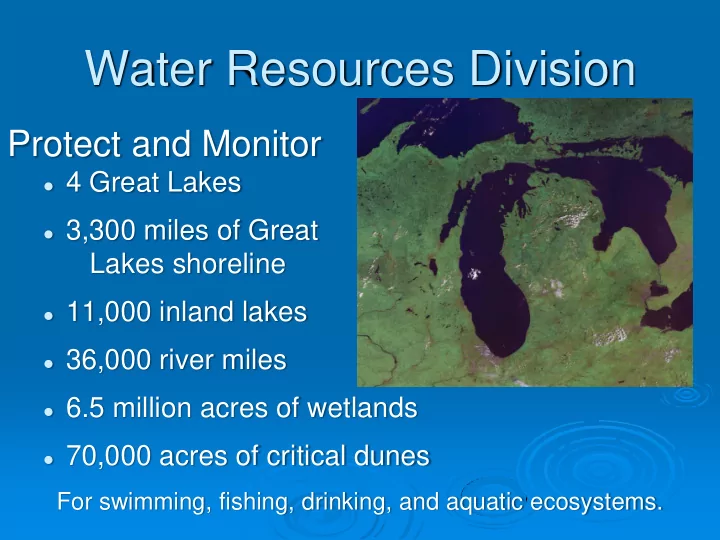

Water Resources Division Protect and Monitor 4 Great Lakes 3,300 miles of Great Lakes shoreline 11,000 inland lakes 36,000 river miles 6.5 million acres of wetlands 70,000 acres of critical dunes For swimming, fishing, drinking, and aquatic ecosystems.
Michigan Nutrient Control Phosphorus based Great Lakes driven
Water Quality Standards 1.0 mg/L Narrative
NPDES Permit Limits 670 permits have some type of phosphorus control 350 permits contain numeric limits Watershed-based rotation
Lake Erie Eastern Basin Central Basin Western Basin 6
2012 GLWQA: Commitments to Develop New Phosphorus Targets & Action Plans Charge to Annex 4 (Nutrients): Starting with Lake Erie by 2016 • Determine phosphorus concentration objectives and loading targets for open waters and nearshore areas including embayments and tributaries. • Determine loading allocation by country and identify priority watersheds for load reduction. Starting with Lake Erie by 2018 • Assess effectiveness of programs to achieve the substance and lake ecosystem objectives. • Develop domestic action plans and strategies to control nutrients.
Annex 4 Objectives for Lake Erie Minimize the extent of hypoxia zones associated with 1. excessive phosphorus loading, with emphasis on Lake Erie. Maintain algal biomass below nuisance conditions. 2. Maintain algal species consistent with healthy 3. ecosystems in nearshore waters. Maintain cyanobacteria biomass at levels that do not 4. produce toxin concentrations that pose a threat to human or ecosystem health. Maintain mesotrophic conditions in the open waters of 5. the Western Lake Erie Basin.
Michigan’s 5 Point Plan to Correct Harmful Algal Blooms in the Western Lake Erie Basin Michigan’s 5 Point Plan Understand the role of invasive mussels in Optimize total Western Lake Erie phosphorus Basin and support the removal at 5 key evaluation of new wastewater technologies treatment plants Reduce agricultural and Implement the nonpoint source phosphorus total phosphorus control activities Cease the open in Maumee River checklist to best watershed water disposal of of ability dredged Toledo Harbor sediments
1. Optimize total phosphorus removal at 5 key wastewater treatment plants. Detroit, Downriver, and YCUA WWTPs in MI; Fort Wayne WWTP in IN; and Toledo WWTP in OH
Summary of Point Source Loads (MT)
Detroit WWTP Total Phosphorus Load Sources 2011 % Total 2012 % Total Secondary Treated 756590 70 751110 94 Primary Treated (WWTP/CSO facilities) 275780 26 48250 6 Untreated CSO 42090 4 2240 0 Total 1074460 100 801600 100
4. Implement the phosphorus control activities checklist to best of ability . Water pollution control programs: Limiting municipal and industrial discharges to a total phosphorus limit of 1 mg/l Combined sewer overflow correction programs Sanitary sewer overflow correction programs Municipal storm water and construction storm water programs Concentrated animal feeding operation permitting and regulation Eliminating phosphorus in detergents and turf grass fertilizers
Invasive Mussels Promote harmful algal blooms: Filter feeding and excretion stimulate nutrient releases into water column Selectively feeding on phytoplankton Reject blue-greens Photo credit: Paul Skawinski, Golden Sands RC&D Council
Zequanox Biopesticide: Dead cells of a common soil bacterium Causes mortality of zebra and quagga mussels Destroys the inner gut lining of invasive mussels Not harmful to other aquatic organisms and does not have lasting impacts on water quality Previous open water trials in Illinois and Minnesota
2014 Lake Erie Zequanox Pilot Feasible in Lake Erie? Things to consider - • Depth • Substrate • Location of actual mussels • Wave action
• La Plaisance Bay • November 2014 • 800 m 2 Treatment Plot Partners: Marrone Bio Innovations, PLM Lake and Land Management, and USGS
• Application technique = successful • Concentrations not maintained • Application technique = successful • Concentrations not maintained 18
Water Resources Division Protect and Monitor 4 Great Lakes 3,300 miles of Great Lakes shoreline 11,000 inland lakes 36,000 river miles 6.5 million acres of wetlands 70,000 acres of critical dunes For swimming, fishing, drinking, and aquatic ecosystems.
Recommend
More recommend